Discussed with Hsiao-Wei her growth experiences, the details determined by the Ethereum technology roadmap, highlights and challenges of community building, and more.
ETHPanda Talk is a program focused on how to build a better digital future based on Ethereum. We invite outstanding Ethereum builders to share their motivations for building Ethereum, the projects they are advancing, and their related experiences and insights, including their outlook for the future. We hope to bring more diverse perspectives or inspirations by exploring the stories and ideas behind these efforts, encouraging everyone to participate in the construction of Ethereum.
In this episode of ETHPanda Talk, our guest Hsiao-Wei Wang joined the Ethereum Foundation as a researcher in 2017 and has been working internally at the Ethereum Foundation for nearly 8 years, participating in multiple significant Ethereum upgrades, including The Merge, Shapella, and Dencun. In April 2025, she just took over as the co-executive director of the Ethereum Foundation, marking her first external interview since assuming office.
In this episode, we discussed with Hsiao-Wei her growth experiences, the details of the Ethereum technology roadmap, highlights and challenges of community building, and her work at the Ethereum Foundation. We hope to provide new ideas and thoughts for everyone.
Hsiao-Wei Wang's Personal Growth Experience
Bruce:
You initially joined as a researcher and grew step by step, so I believe many viewers are interested in your personal growth experience. You mentioned entering the industry in 2017; were there any important people or moments that brought you here, and what motivated you to join Ethereum? Can you share some of your thoughts along the way?
Hsiao-Wei:
My personal background is in computer science, and after graduating with a master's degree, I entered the telecommunications field, based in Taiwan. During this time, there was a training session within the company focused on blockchain, mainly discussing Bitcoin.
In 2016, there were not many blockchain startups in Taiwan; most were exchanges that allowed the general public to buy Bitcoin. I was contemplating whether it was time to switch careers when a college classmate mentioned that their company was about to establish a blockchain research department, so I submitted my resume. Later, I was fortunate to meet a former colleague from my previous job, who was also a former colleague at the Ethereum Foundation, Chen Chang-wu (now at ImToken). He had gone to the Ethereum Foundation as a researcher. Around 2017, the Foundation was hiring researchers in Asia, so I applied as well. The Foundation represented a very special opportunity for me because I had learned about Ethereum and experienced its community culture at my previous company. I felt that besides Bitcoin, there were many blockchain innovations, and Ethereum was particularly attractive, which is why I joined the Ethereum Foundation.
Bruce:
In your many years as a researcher, what have you done or learned that made you feel like you suddenly leveled up, achieving a significant breakthrough or sense of accomplishment?
Hsiao-Wei:
As an Ethereum researcher, about half of our research gets adopted, while the other half may not. The Beacon Chain underwent many changes in its roadmap. I felt that it wasn't until the Beacon Chain went live that we finally found a definitive path. Whether it was PoS or the Sharding aspect, we found an integrated route. The previous research wasn't wasted; some of it was applied, but at that time, there was a sense of having endured hardship to achieve success.
Bruce:
We also know that in 2022, Ethereum completed The Merge, officially transitioning from PoW to PoS, a challenge often likened to changing engines mid-flight. After being involved throughout the process, what do you think was the biggest challenge? Are there any lesser-known stories?
Hsiao-Wei:
Since we already had many things on-chain and many people involved in the project, coordinating human resources was the biggest challenge.
Here's a little tidbit: the Deposit Contract has many leading zeros because it is an address that everyone will use for many years to come. So, the person responsible for deploying it spent some time calculating to generate this unique address to reduce the risk of phishing scams. We also took measures in many places to prevent other scammers from using the Deposit to defraud people. So, we put some thought into creating this contract address with many leading zeros.
(Deposit Contract: 0x00000000219ab540356cBB839Cbe05303d7705Fa)
Bruce:
I remember there was a panda meme related to The Merge; how did you come up with that?
Hsiao-Wei:
It was a Dragon Ball reference. At that time, I was preparing to give a presentation introducing The Merge, and I was thinking about how to help everyone understand that we weren't just discarding the original chain but rather merging it with the Beacon Chain, which includes the Consensus Layer. I happened to find a panda merging meme image, featuring a black bear and a white bear. It was created by a Thai artist. We used it as a metaphor, and it became very popular.
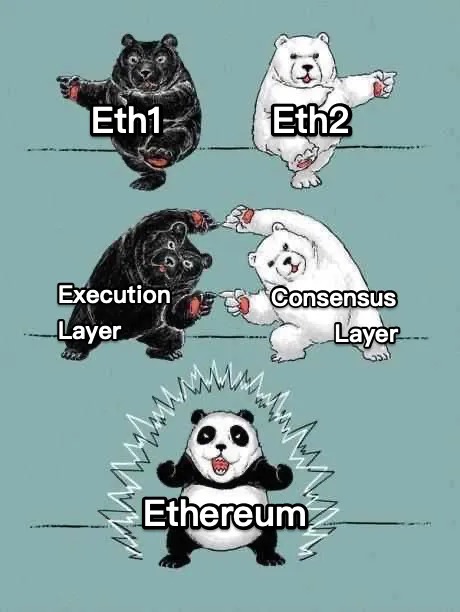
The Merge Panda meme
So, ethPandaOps was established at that time; they were a very strong DevOps team behind The Merge, responsible for Ethereum network operations, and they later named themselves ethPandaOps.
Bruce:
In recent years, we've seen significant fluctuations in the industry, and there are often so-called Ethereum killers. During this process, have you ever felt emo or questioned whether what we are doing has value? If you have felt down, how do you persist?
Hsiao-Wei:
Some people use blockchain technology for bad things, which can create a very negative perception among the public, leading the general populace to view crypto as somewhat speculative. In this industry, we hope for technological progress, and this phenomenon is something that those of us with a better vision find quite sad.
Fortunately, my colleagues around me share a similar atmosphere. Of course, education is also important, but we may not be able to change everyone's negative impressions of blockchain overnight. However, if there are good things happening on blockchain or Ethereum, we hope to promote them; that's what we can do.
Bruce:
I also feel that choosing to be with builders is very important for the environment. But if you feel down, you can huddle together for warmth, do some research and experimentation together, and gradually it might get better.
Hsiao-Wei:
But another aspect I want to emphasize is that sometimes you need to step out of the ivory tower and listen to some negative opinions. Because recently, I've been working hard on that.
Ethereum Technology Roadmap and Future Development
Bruce:
We often see Vitalik updating and releasing a complex roadmap filled with various terms every year. Can you explain how the roadmap is designed, how it is determined, and how it is advanced? What is the general process?
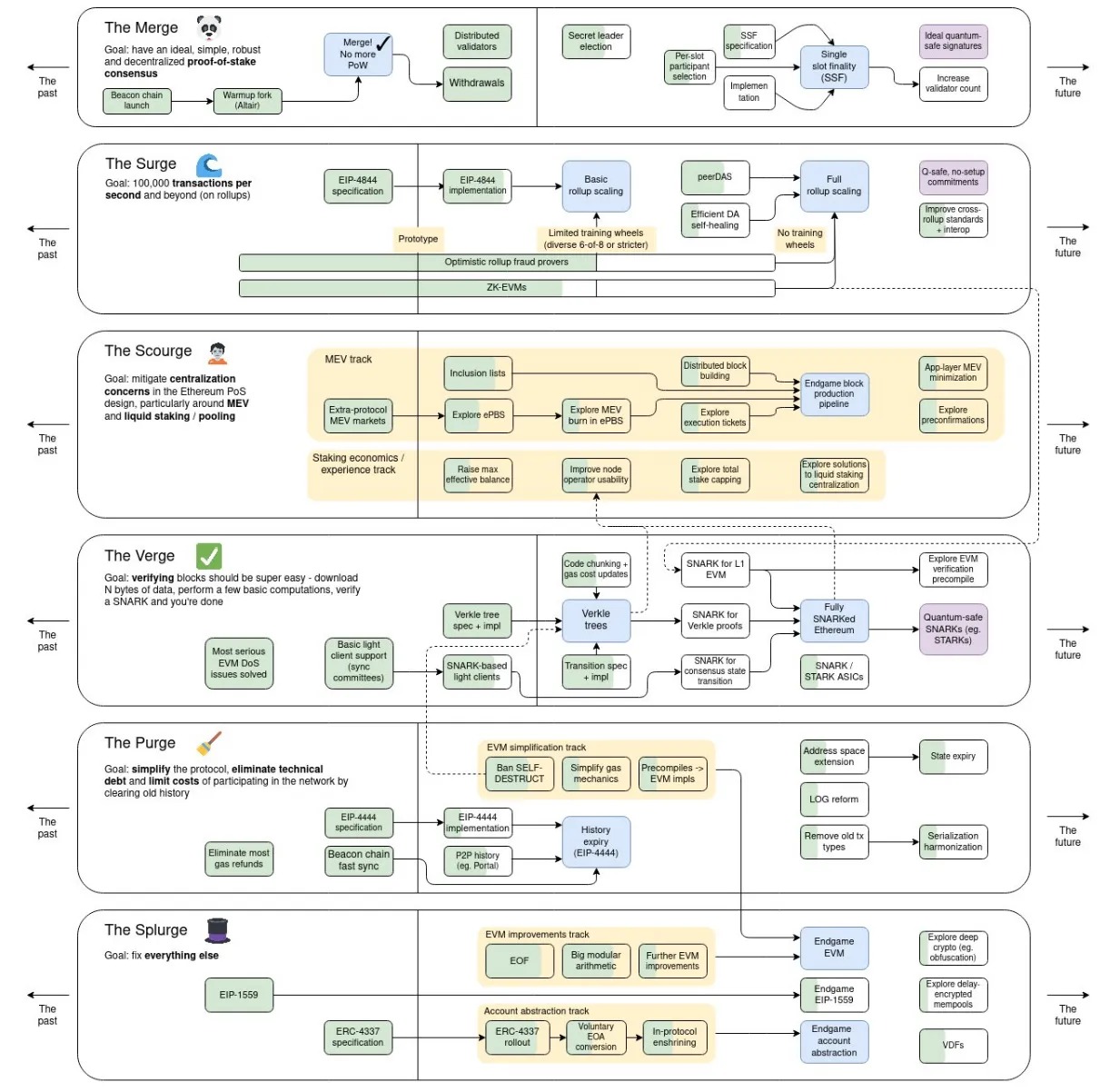
Vitalik’s Ethereum Roadmap in 2023
Hsiao-Wei:
Vitalik has been releasing this diagram for more than three years. Last year, we urged him to release it, and he chose to write six articles titled: Possible futures of the Ethereum protocol.
His technical roadmap serves as a high-level guide, indicating the direction we want to take. Internally, there are plans A, B, and C, and which one is easier to succeed is something developers and researchers need to consider this year. He provides a high-level idea, which also serves as a channel for community communication. However, the actual development progress and direction are still determined by our community's core developers. When he draws this diagram, it is quite simple, and researchers' ideas are incorporated. The subsequent implementation of this roadmap presents different options.
Many EIPs may have existed for 3 to 5 years before being put on-chain. A proposal is first created, and the time it takes for a proposal to be adopted can vary widely. Perhaps it was only added a few weeks ago, like EIP-7702, which was adopted relatively late.
On Ethereum's GitHub, there is an EIP repository where anyone can submit an EIP proposal using a template to describe how they want to change the protocol. When this proposal receives significant attention and review, it has the opportunity to be discussed at the ACD (All Core Devs weekly meeting), allowing all client developers and researchers to discuss it.
Typically, someone who strongly supports this EIP will attend the meeting to present it, and others will provide feedback and signals. If this EIP has a lot of support, it is more likely to be adopted. The process goes from discussion at ACD to the final EIP inclusion meeting. Last month, because Pectra was about to hard fork in early May, everyone had already started planning the content for the next hard fork.
When an EIP is very likely to be adopted, we tag it as CFI (Consider for Inclusion), sending a stronger signal for the industry to pay attention.
In summary, Vitalik sets the general direction but does not delve into very specific content; researchers push forward in these directions. At the same time, anyone can submit an EIP to inform the community of desired changes, which is then discussed in ACD meetings, improved based on community feedback, finalized, and published as an EIP. After that, various client teams begin developing the changes, which are then launched at the scheduled time.
The main organizers of ACD over the years have been people from the Ethereum Foundation (EF), and EF is also considering how much leadership we need to provide. Each hard fork is somewhat different. For example, the Core Devs for the Pectra upgrade each have their own user requests for adoption, so the final scope is quite broad. However, for Fusaka, there is a consensus that we need PeerDAS, which simplifies the process significantly as there is a more cohesive agreement among everyone; each coordination effort varies.
Bruce:
This process is quite interesting; it doesn't operate like a company but rather involves the entire community participating in driving a widely impactful upgrade. What practical changes do you expect from the Pectra upgrade coming in May? Which EIPs do you find most promising?
Hsiao-Wei:
Each EIP has its own purpose, but the one that will have the most significant impact on developers and applications is EIP-7702. It allows you to set a code for your original EOA address; if the original code unit is empty, you can change its value. It simply provides functionality, but the design possibilities for what that code can be are very broad. We hope this change can unlock some designs for account abstraction, paving a wide path. How you design this AA contract on Layer 1 and how to design it on Layer 2 offers many choices.
The Ethereum Foundation is also actively negotiating a universally applicable standard for the industry. Of course, this is very interesting; we hope for more designs and innovations. At the same time, we also hope that everyone uses safe contracts.
Bruce:
I've recently been looking at EIP-7702, and I think the potential is indeed vast. Previously, we had to click through various pop-ups, but now we can consolidate them into one transaction. This includes Gas Fees and sponsorship payments. However, I also feel that if it's too flexible, it could introduce some security risks. What are your thoughts on how we can better protect security?
Hsiao-Wei:
First of all, the AA contract must undergo a complete audit. The Foundation also provides implementation cases to enhance trust in using contracts. Many teams are integrating this functionality into wallets.
Bruce:
In fact, Ethereum scaling is a long-standing topic. We often see terms or concepts like sharding and ZK. From your perspective, could you briefly introduce what ZK rollups and sharding are, what important work is being done, and what the main challenges are?
Hsiao-Wei:
The concept of sharding actually comes from database design. In earlier designs, we had an open main chain with some shard chains below it. However, now we have a rollup-centric roadmap that goes upwards rather than downwards, with Layer 2 above. This means we can see sharding and ZK rollups scaling Layer 1 development simultaneously. Recently, the main focus has been on how to increase the number of blobs. Blobs are part of Ethereum's data layer, and once enhanced, Layer 2 can periodically transmit hash values to Layer 1, and we hope to increase the frequency of this.
So, if we scale Layer 1, it actually helps Layer 2 as well; the two together enhance the overall output of Ethereum.
Bruce:
Where are the main challenges? What can be done to accelerate this development progress?
Hsiao-Wei:
Currently, the main goal is testing. We have many clients. The research part, including the design of cryptographic algorithms, is nearly complete, but the network layer presents engineering challenges. More testing and parameter adjustments are needed. Perhaps one client may perform well in internal testing, but there could be issues when it comes to interoperability. Therefore, the primary goal is regular testing. It's also beneficial for everyone to spend some time testing on the testnet.
Development of the Ethereum Ecosystem, Applications, and Community
Bruce:
The Ethereum ecosystem includes not only the protocol layer but also applications and communities. Which applications do you think have explosive potential? What are your observations or thoughts?
Hsiao-Wei:
Personally, I find aspects like identity or SocialFi design interesting. Recently, I find the mini-programs on Farcaster intriguing. You can see what your friends are using and what games they are playing, and you can immediately share that on social platforms. These mini-programs can easily integrate into the lives of general users, but it will take some time for them to explode. In terms of innovation, it might quickly find user groups to adopt.
For larger projects, I wonder if there will be some interesting designs in finance over the next year or two. One part is DeFi, where I hope to see more innovative application cases. Another part that has recently gained popularity is RWA, which should also fall under the category of applications.
Bruce:
Many Ethereum communities are spontaneously formed by local enthusiasts and volunteers. However, manpower and funding can sometimes be unstable. From your perspective, do you think communities have more robust and sustainable development methods? Have you seen any good examples of communities doing well?
Hsiao-Wei:
I am also a co-founder of the Taipei Seminar and ETHTaipei. Many members of the community in Taiwan are from open-source communities; some may be members of Python PyCon or have previously been involved in other communities with an open-source spirit. So, many people want to use the open-source spirit to contribute to Ethereum.
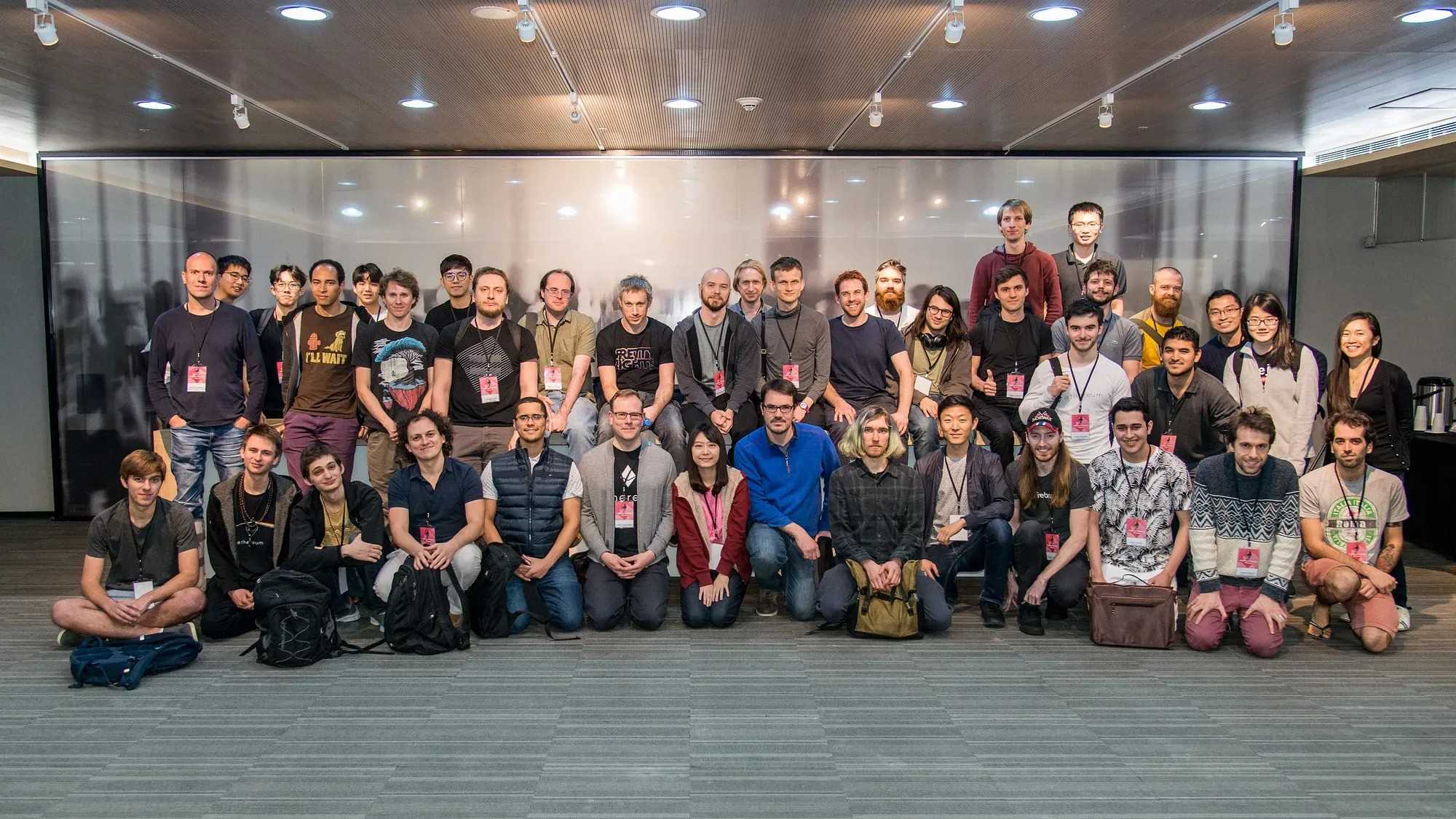
March 19-21, 2018 - Ethereum Sharding Workshop in Taipei
What’s interesting in Taiwan is that people have no problem doing things for the public good. We work during the day and come together at night to dig holes, fill them, and get things done.
However, this behavior model requires continuously bringing newcomers in. How do you pass this spirit on? I think continuously onboarding new people is very important.
Since it is an open-source community, individuals do not have significant ownership within the community; everyone contributes a little. If no one is there, then that becomes your job. If there is no open-source background, it can indeed be challenging to implement this model elsewhere.
There are many interesting designs in the Chinese-speaking community, each with a different style. Perhaps because Taiwan is relatively small, it seems that the people doing the work are the same group. The diversity is somewhat lower than in other places. In larger areas, various projects emerge like mushrooms after rain, which I think is great.
Bruce:
Speaking of the diversity of communities, since 2018, you have been promoting various Ethereum communities, including the development of ETHTaipei. What advantages or challenges do developer communities in Asia have? What role do we play in the global Ethereum system?
Hsiao-Wei:
I think there are many talented developers in Asia. The strength of Asia lies in product development and user experience. I feel that Europe and the U.S. may have a longer history of researching Ethereum. So, there are sometimes cultural differences between the two sides. I think it is important to maintain unique characteristics, and better communication would be even better. For Ethereum to become a world computer, we must face global users and developers, so I hope to bridge cultural gaps through communication.
Bruce:
I share that sentiment because there are many people in the Asia-Pacific region, and there are certain cultural similarities. Therefore, we tend to have more experience in user experience and application layers. From an overall perspective, what community-related work do you think lacks promotion or support? In other words, what areas remain undeveloped or relatively blank that we can push to improve the entire Ethereum ecosystem?
Hsiao-Wei:
In recent years, AI has made things so convenient that reading English information doesn't seem to be a big issue. Thanks to ETHPanda, which will soon provide Chinese summaries on Twitter with a quick response time. However, I think the demand for translation may decrease in the coming years as everyone enjoys the benefits of AI. We need to bring in more new blood. I have been in the community for seven years, so I am truly one of the veterans. How do we onboard more newcomers? I hope to promote this mainly within student communities.
Work of the Ethereum Foundation
Bruce:
Now that you are the co-executive director of the Ethereum Foundation, how has your daily work changed since transitioning from a researcher to this executive director position? What new challenges have you encountered?
Hsiao-Wei:
I must accept the speed of change. My previous main work and activities were primarily at the Consensus Specs level. I thought I could still come back to review PRs when I had free time. However, in the past month, the core focus has shifted to management. At the same time, I need to closely monitor the latest developments in research. Challenges truly come from all directions.
I feel very honored and grateful to work alongside my partner Tomasz as co-executive directors. He is very proactive in collecting feedback from the community and translating that feedback into a broader roadmap for EF. On this difficult path, I feel I am not alone.
Bruce:
I can relate to that. Tomasz often posts on Twitter, inviting people to contact him. I have also posted something, and the next day he immediately set up a group to connect with EF colleagues, which I think is a very positive change.
In the past quarter or the last few months, EF has frequently adjusted its organizational structure and personnel, including new external organizations like Etherealize. Can you introduce the background and goals of these changes?
Hsiao-Wei:
I can first introduce the general structure of EF. First, we have a board of directors, followed by a management team, which oversees three business clusters, which are not strictly defined departments. The first is the Operations department, including Finance, HR, and Legal, which are necessary for the daily operations of a company or foundation. The second is the Development department, which, after some significant spin-offs recently, is now primarily focused on Protocol R&D, with the Research Team also within this development department. The third is the Eco Dev department, which is related to ecosystem development, and this part may include departments that issue grants, such as ESP and the Next Billion Fellowship.
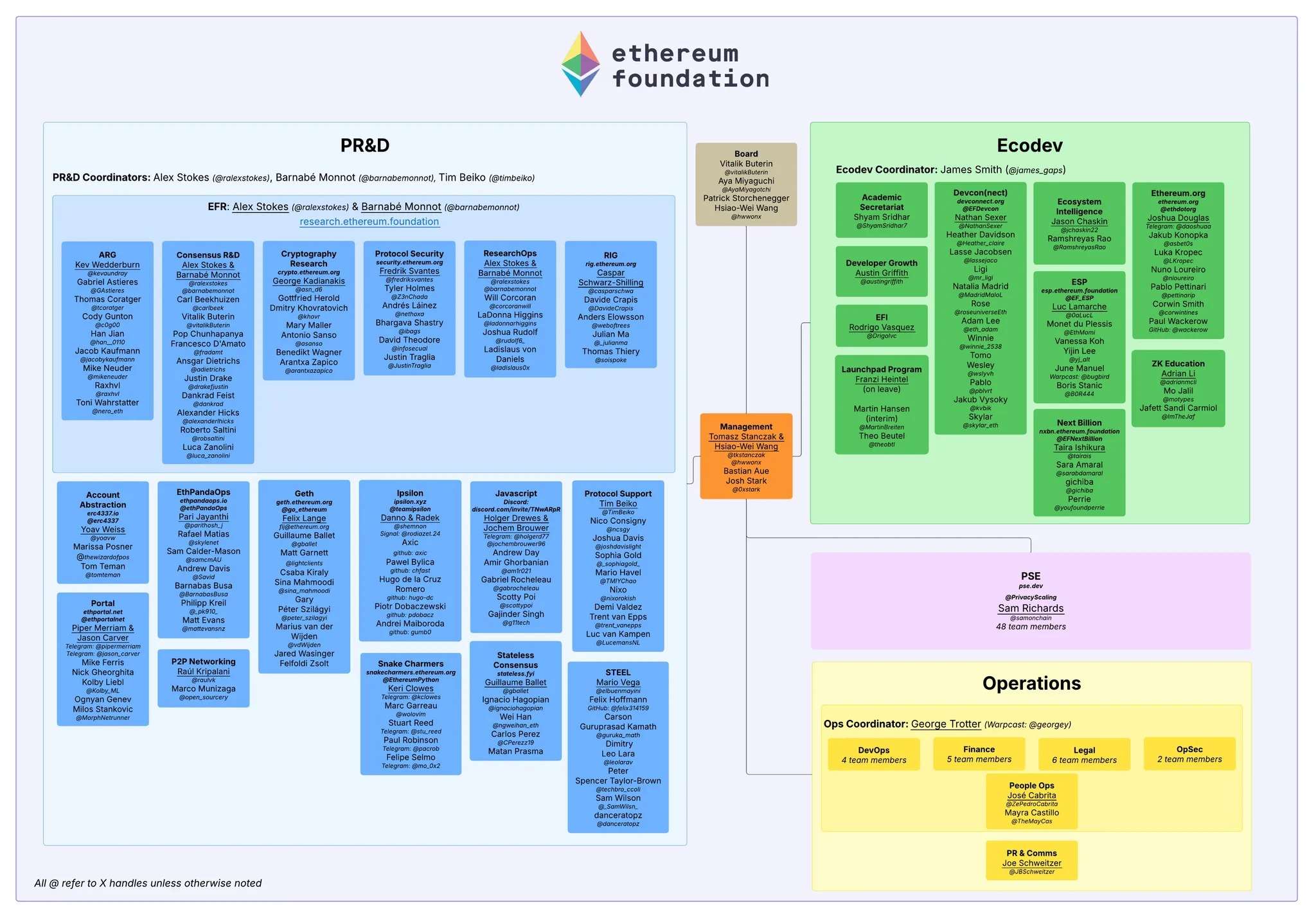
Bruce:
Can you briefly introduce some external organizations related to EF, such as Etherealize?
Hsiao-Wei:
If I remember correctly, Etherealize was actually established last year. The Foundation and Vitalik provided some support during their early establishment. They mainly focus on activities in Wall Street in the U.S. This also reflects the shift in the global political landscape regarding crypto. Their establishment allows them to operate in Wall Street and do things that I think are very helpful for us, doing things that EF might not directly execute. Their business development (BD) part can better engage directly with U.S. users and traditional financial institutions or large companies, which I think is great.
Bruce:
I just heard that EF does not have a marketing team, right?
Hsiao-Wei:
Correct, we only do communication. As Josh Stark said, Ethereum doesn’t have a BD team; Ethereum has one hundred BD teams. Other applications, whether Layer 2 or some DApps, have their own BD teams, which are also like our BD team.
We do not view Ethereum as a brand of our own. For example, on Twitter, we have recently made some account transitions. Since the beginning of this year, there is now an Ethereum account and an Ethereum Foundation account.
I think separating them is quite good because previously, whenever we wanted to post something using the Ethereum account, it seemed like everyone thought it represented the Foundation, which was very limiting. Now, we can use this account to do BD-like activities, helping the community understand what major events are happening. I think this separation is great; both accounts can be utilized effectively.
Bruce:
This also brings a lot of convenience to our work. The official Ethereum account is a great source for us to translate and introduce content, allowing us to get the latest changes and provide better publicity for the community.
You also mentioned ESP, which is a very important part of EF and has always played a role in boosting the development of the entire ecosystem. After this new structure, are there any changes in the budget allocation design for EF, particularly in the areas that ESP will focus on?
Hsiao-Wei:
I just mentioned that we have different departments like Eco Dev and Development. The team leads of these developers and researchers are now capable of managing larger grants. ESP and other Eco Dev teams are part of this. The main areas of focus might include AGR, which is not internal to ESP but is somewhat tied to it, as it pertains to academic research, with grants awarded once a year. The application for this year should have ended and is currently under review.
In other areas, I think ESP serves as our front for receiving inbound requests, so their choices are quite broad. They are not strictly defining how much budget to allocate for activities.
What the Ethereum Foundation wants to support is not always necessarily through grants or monetary support, but rather through the Foundation's shout-outs (publicity).
When the Foundation decides whether to grant funds for activities, it does not always directly consider how many users the activity can bring us. Instead, it looks at what kind of grant allocation can have a greater impact, which activities or projects can only be supported by the Foundation, and whether they are useful and can provide public goods that benefit everyone.
Bruce:
To summarize, these activities or projects may be the only ones that the Foundation is willing to support, and the things themselves are necessary.
I have also seen EF bringing in more external organizations to participate in decision-making, such as the recent Forestry Association (The EF Silviculture Society)?
Hsiao-Wei:
They are somewhat like a council; we have selected some advisers who are very public-interest-oriented in different fields, and we are very grateful to them. I think they mainly represent the spirit of Cypherpunk, as well as security and privacy.
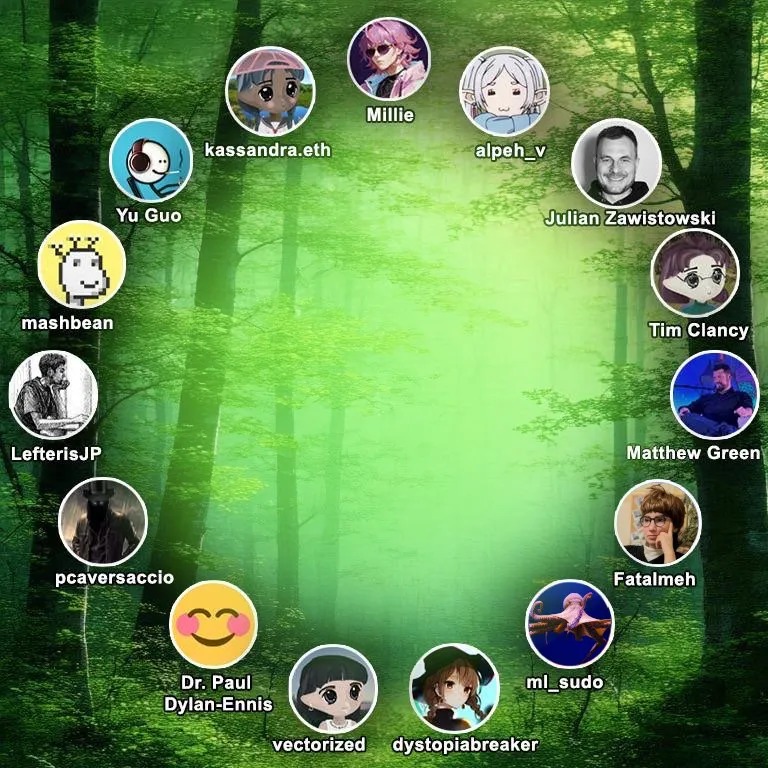
If we consider Ethereum as a business, having business advisers allows us to easily hear a lot of opinions. How do we better listen to the voices of the community? That is the significance of forming this council.
In other aspects, we have also been listening to the opinions of DeFi experts recently. The EF has also conducted many Twitter Spaces to actively communicate with successful projects in Layer 2 interoperability and various DApps. Additionally, external project team leaders come in to give seminars to EF internally. We gather expert opinions and community feedback through these methods.
Bruce:
Some have suggested that the Ethereum Foundation should generate revenue through DeFi rather than continuing to sell tokens publicly. What do you think about EF's funding operation model? What potential input channels can ensure the long-term sustainability of the Foundation?
Hsiao-Wei:
This year, the Foundation has started to actively participate in DeFi. In early February, we deployed some initial attempts at ETH DeFi lending, and a second phase is also in the planning. We are evaluating whether to increase our lending investments or explore more creative ways to utilize ETH assets. The second major area is staking. We are also exploring different staking options while considering whether EF's participation in staking can bring positive benefits. The third point, still in the exploratory stage, is tokenization, such as participating in some RWA. Our involvement mainly concerns more conservative funds or funds that are favorable to Layer 1.
Bruce:
It seems there are still many new ideas and attempts in this direction. The community has also provided some feedback, including occasional sales of 100 ETH, which, while not causing significant selling pressure, may affect community sentiment. What is the internal view of the Foundation on this?
Hsiao-Wei:
How should I put it? For us, it is a necessity to sell because we currently have two to three hundred people in the Foundation, and about 75% of our expenses need to be in fiat currency, while 25% is in crypto. So the first point is that the Foundation needs to operate, which requires asset rebalancing.
The second point is that the community may not fully understand this need, and we will strengthen our communication on this. One more thing to clarify is that we do not sell at high points; many people say we sell at high points, but in fact, many times we sell at low points. When we sell at low points, people do not amplify that; we do not have much design around this.
Bruce:
I have also seen community voices suggesting that we could use OTC methods or some more discreet ways. What do you think about that?
Hsiao-Wei:
Our main treasury is very open and transparent, so perhaps doing this in the short term is possible, but the major treasury changes are visible to everyone.
Bruce:
Regarding the work of the Ethereum Foundation, some speculate that EF may gradually fade out or dissolve after completing certain missions or stages, allowing the community to drive Ethereum's operation. What is your view on this direction? If that day really comes, how do you envision the Ethereum community operating?
Hsiao-Wei:
First of all, this year is particularly important for the Foundation. We have invested a significant budget in the overall organizational transformation. Perhaps next year, if the Foundation finds that other entities within the community can replace its role, we can operate in a conservative and contracted manner. Interestingly, we need to adjust our strategy each year; the themes the Foundation focuses on may vary. When the Foundation focuses on the protocol, its presence may be stronger.
So perhaps in the future, if the focus shifts to application layers or wallets, we may not need such a strong presence, so this presence changes every year. Personally, I hope the Foundation can constantly think about how to enable others to do what we are doing today. In the future, if there are things that only we can do, we may continue to do them. For example, coordination heavily relies on various future factors and support from the community. If the community can perform well, the Foundation can shift to more complex matters or those that lack attention.
Bruce:
We are nearing the end of this interview. We have discussed a lot, including personal experiences, technical roadmaps, community, and the work of the Foundation. Let's wrap up with some lighter topics. Since our audience includes students and younger developers, as a "veteran" in Ethereum, what advice do you have for those just starting out or wanting to enter the field?
Hsiao-Wei:
I think many people say that choice is more important than effort; I would add that you should choose places where you can have more choices. Ethereum has a very large and vibrant community, and many developers have paved the way ahead. I hope new members can develop in this field, whether you are a developer, educator, product manager, or user; you can find mentors in the community to give you more options.
Bruce:
Can you recommend some books or resources that are helpful for building a Web3 mindset or for personal growth?
Hsiao-Wei:
I often read Vitalik's blog posts. If the level of thinking is two-tiered, you might want to see how people at the four-tiered level think, which is a more advanced way of thinking.
Recently, I have also been reading management books. One book is called "Principles," which outlines some overarching directions and principles. I think the important takeaway from this book is that you need to establish your own principles. His principles may not apply to me, but the important thing is to establish principles. If you can follow those principles, then the things you do afterward may become much simpler.
Bruce:
In your spare time, do you have any favorite sports or other leisure activities?
Hsiao-Wei:
I am quite a homebody; I mainly watch TV shows and play international chess, which are more static activities. However, my leisure time has significantly decreased recently due to a lot of work.
Bruce:
Thank you for sharing today, Hsiao-Wei. I really appreciate the interesting and deep insights you've provided. Thank you all for watching or listening to this episode of ETHPanda Talk. A special thanks to Hashkey for providing us with a free venue. If you enjoy our content, please follow, share, and support us. See you next time!
免责声明:本文章仅代表作者个人观点,不代表本平台的立场和观点。本文章仅供信息分享,不构成对任何人的任何投资建议。用户与作者之间的任何争议,与本平台无关。如网页中刊载的文章或图片涉及侵权,请提供相关的权利证明和身份证明发送邮件到support@aicoin.com,本平台相关工作人员将会进行核查。




